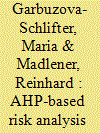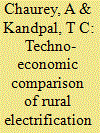| Srl | Item |
| 1 |
ID:
150067


|
|
|
|
|
| Summary/Abstract |
Understanding and properly managing risks that could potentially affect the target- and performance-based profits of energy performance contracting (EPC) projects are essential. It is particularly important for the establishment and success of energy service companies (ESCOs) acting in the vulnerable environment of the vast but highly energy-inefficient Russian market. This study systematically explores common risk factors and causes of risk associated with EPC projects executed in three Russian sectors: (1) industrial; (2) housing and communal services; and (3) public. Several interviews with the Russian EPC experts were accomplished and a qualitative risk assessment by using an analytic hierarchy process (AHP) approach. The data were obtained from a web-based questionnaire survey conducted among Russian EPC project executors. For each focus sector, a specific preference-based ranking of the identified risk factors and causes of risk was derived. The AHP results show that causes of risk related to the financial and regulatory aspects contribute most to the riskiness of EPC projects performed in all three focus sectors in Russia, calling for the special attention of EPC policy- and business-makers. Due to sectorial particularities and different actors involved, we conclude that there is a need for elaboration of sector-specific contractual schemes for EPC projects.
|
|
|
|
|
|
|
|
|
|
|
|
|
|
|
|
| 2 |
ID:
168299


|
|
|
|
|
| Summary/Abstract |
Energy efficiency is widely recognized as a cost-effective strategy to meet energy demand. The U.S. energy service company (ESCO) industry generates significant energy savings and other benefits through installing and maintaining energy efficiency, renewable and other types of projects. In this study, we evaluate factors that may explain trends in the economic performance of U.S. ESCO projects by analyzing project level data for ∼7000 U.S. ESCO industry projects. We find that real project investment levels normalized for floor area have increased over time in ESCO projects across market segments. However, the dollar value of energy savings and other reported benefits have not kept pace with increases in real project investment levels over time. The latter have increased 100%–500% in various market segments from 1990 to 2017. We conduct an econometric analysis to decompose the drivers of these underlying trends. Number of measures and a changing mix of conservation measures are the primary factors that correlate with the long-term increase in project investment levels. However, our analysis is only able to account for less than 50% of the increase in real investment levels. We discuss additional factors, and conclude discussing policy implications and outlining long-term research needs.
|
|
|
|
|
|
|
|
|
|
|
|
|
|
|
|
| 3 |
ID:
176903


|
|
|
|
|
| Summary/Abstract |
This paper focuses on energy performance contracting (EPC) projects that can potentially reduce carbon emissions. Based on the reasons for financing difficulties in China's EPC projects, the paper delineates opportunities for the energy-saving service industry as well as the ownership of carbon emissions. According to the transaction cost and resource dependence theories, this paper constructs a financing mode for EPC projects based on the total amount of control and quota trading. Financing mode is divided into two types according to the carbon emissions objectives noted by emissions demanders: self-use and non-self-use. Each financing mode is then categorized as either pre- or post-transaction given the differences in carbon emissions trading periods, and their characteristics are compared. Regarding carbon emissions ratings, a parabolic fuzzy number is used to describe how carbon emissions trading prices fluctuate and how the risk-neutral probability and weighted interval of European call option prices are obtained. The option price interval is then converted into a certain value by defuzzification. The financing mode this paper designs not only improves the possibility of EPC projects' financing and profitability, but also expands energy service companies' scope in choosing projects. This paper's carbon emissions rating method enables participants' understanding of the magnitude of uncertainty, obtains more accurate market price forecasts, and helps investors choose their acceptable confidence levels to guide investment strategies.
|
|
|
|
|
|
|
|
|
|
|
|
|
|
|
|
| 4 |
ID:
096152


|
|
|
|
|
| Publication |
2010.
|
| Summary/Abstract |
Solar home systems are typically used for providing basic electricity services to rural households that are not connected to electric grid. Off-grid PV power plants with their own distribution network (micro/minigrids) are also being considered for rural electrification. A techno-economic comparison of the two options to facilitate a choice between them is presented in this study on the basis of annualised life cycle costs (ALCC) for same type of loads and load patterns for varying number of households and varying length and costs of distribution network. The results highlight that microgrid is generally a more economic option for a village having a flat geographic terrain and more than 500 densely located households using 3-4 low power appliances (e.g. 9 W CFLs) for an average of 4 h daily. The study analyses the viability of the two options from the perspectives of the user, an energy service company and the society.
|
|
|
|
|
|
|
|
|
|
|
|
|
|
|
|